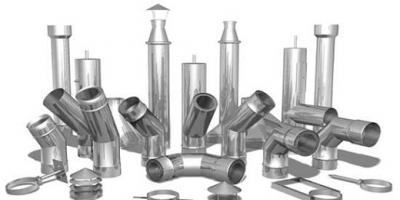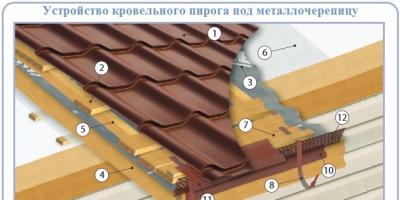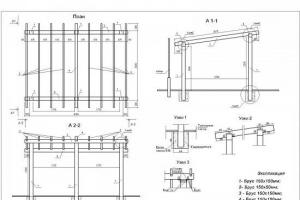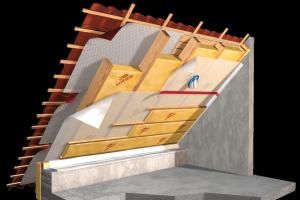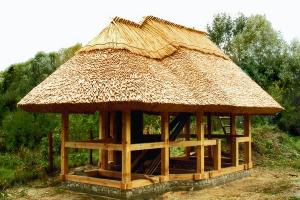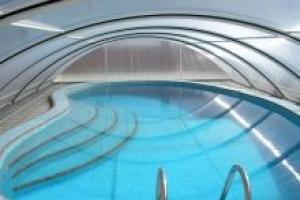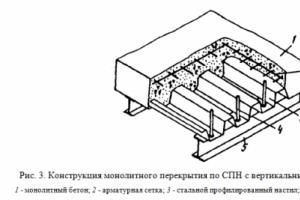Choosing a roofing covering is an important step in building a house, because the lifespan and ease of use of the roof depend on the correct choice. When choosing a roofing material, preference is often given to inexpensive and popular types of covering, such as profiled metal sheets or Euro slate. At the same time, the question often arises: what is better – ondulin or corrugated sheeting? In order to make a smart choice, it is necessary to consider the characteristics of these materials and their features.
What is ondulin?
Ondulin, or Euroslate, is wavy sheets of thick cardboard impregnated with bitumen under high pressure. It is flexible and quite lightweight - the weight of one sheet does not exceed 7 kg, while the impregnation provides excellent protection from moisture. Ondulin comes in several standard colors, its surface is slightly rough and velvety to the touch. It is a soft material that can be easily cut to size, drilled and nailed, making it easy and quick to install.

In operation, ondulin has a number of advantages:
- Low price and long service life (25-50 years);
- Lightweight material that does not require continuous sheathing. Does not weigh down buildings, unlike traditional slate;
- Due to ease of processing and flexibility, it can be used to cover roofs of complex shapes with valleys, abutments, and turrets;
- Easily withstands snow loads up to 0.5 meters thick;
- Has excellent noise absorption;
- Not subject to corrosion or damage by microorganisms;
- It warms up and freezes quite slowly, so it does not form condensation or ice;
- Environmentally friendly material, does not contain asbestos.
However, in addition to its advantages, ondulin has a number of disadvantages:
- Fire hazardous. Bitumen impregnation is highly flammable and supports combustion;
- It fades in the sun over several years and changes color;
- The rough surface retains dust, debris, and snow in winter, and therefore requires periodic cleaning;
- On the north side of roofs, in damp places it is often covered with moss and lichens;
- It softens in the sun and becomes brittle in the cold, so ondulin cannot be installed or exposed to stress in hot or cold weather;
- On the Russian market there are often counterfeits of ondulin that lose their performance within two to three years.

What is corrugated sheeting?
Roofing corrugated sheets are galvanized metal sheets with a wavy cross-section, coated with protective varnish or polymer paint. Corrugated sheeting has a different profile, wave height, and thickness of the material itself. The width of the sheet is usually about a meter, and the manufacturer cuts the length into standard sheets of 6 meters or according to the length of the slope to order. The weight of a square meter of material is from 5 to 8 kg. The corrugated sheeting is secured to the roof using special self-tapping screws with a sealing washer.
The advantages of corrugated sheets include:
- Low price, service life - up to 50 years;
- Absolutely non-flammable, which is important for houses with stove heating, fireplaces, and for covering the roof of bathhouses;
- Does not require reinforced sheathing, it is enough to lay the boards in increments of 0.3-0.5 meters;
- When ordering sheet length according to the size of the slope, the number of joints is minimal;
- Thanks to the wavy profile, it can easily withstand not only the snow load, but also the weight of the human body. Strength does not decrease in heat and cold. Therefore, installation can be done at any time of the year;
- The surface of the corrugated sheet is absolutely smooth, so it does not retain snow, debris and water;
- Corrugated sheeting does not fade, is not subject to corrosion while maintaining the integrity of the coating;
- Eco-friendly material, does not contain harmful substances.
Disadvantages of corrugated sheets:
- Low level of noise absorption. Raindrops or hail can be heard not only in the attic, but also in the upper floor. If the corrugated sheeting is poorly fastened to the sheathing, the material may bend in strong winds, accompanied by an unpleasant sound;
- Due to the possible formation of condensation or ice in houses with an attic floor, mandatory roof insulation is required;
- In hot weather it gets very hot, which worsens the microclimate of the upper floor;
If the coating is severely damaged, corrosion may occur.

Fastening corrugated sheets is an easy procedure
What is better – ondulin or corrugated sheeting?
Taking into account the given characteristics and features, you can compare these roofing coverings and select the most important parameters. The service life and price of these materials are approximately the same, and these roofing coverings are also absolutely environmentally friendly, so the choice should be made depending on the installation and operating conditions.
- Fire hazard. Ondulin is flammable, corrugated sheeting is not. For homes with stove heating, corrugated sheeting will provide better protection against sparks.
- Ease of installation. Corrugated sheeting can be ordered in any size; ondulin has standard sheet sizes. Ondulin is flexible and easy to cut; corrugated sheeting on an irregularly shaped roof is much more difficult to lay. Therefore, for simple roofs with a slope length of no more than 12 meters, corrugated sheeting is more convenient; for roofs of complex shapes or with a large slope angle, it is better to choose ondulin.
- Noise absorption. Ondulin, unlike corrugated sheeting, does not conduct sound of falling drops, hail or wind well. For houses with an attic floor, as well as in regions with frequent downpours, hail and strong winds, ondulin is more convenient.
- Maintaining appearance. Corrugated sheeting does not fade in the sun; after a few years, ondulin changes its color and becomes faded. Therefore, in hot areas with a lot of sunny days, corrugated board will retain its appearance longer. In addition, the color of corrugated board can be easily refreshed by painting it.
- Need for cleaning. Ondulin is susceptible to overgrowing with moss and dust. In winter, snow quickly sticks to the surface of ondulin and is difficult to remove; it must be cleaned. The corrugated sheet is smooth, all dust and debris come off it along with precipitation, so it does not require cleaning. This is especially convenient for houses with several floors, where cleaning the roof involves the danger of falling from a great height.

What exactly to choose, ondulin or corrugated sheeting, depends on local conditions, layout, number of floors and location of the house. The above comparative analysis will help you choose the right roofing material, making the best use of the advantages and eliminating the disadvantages of the coating.
No matter what a person builds, a toilet in the far corner of a summer cottage or a three-story cottage, one always has to look for the answer to the question of how to cover the roof.
In general, there is something to buy on the construction market, both for the gazebo and for the house. Some people can afford something that is more expensive, others need to find something that is cheaper.
Some are guided by certain criteria of reliability and strength, others are guided by color... Most often, an ordinary resident building his own house faces a choice between ondulin and corrugated sheeting.
What is ondulin? A roofing material that appeared relatively recently on the CIS markets was invented and began to be produced in Europe about 50 years ago. Due to its external similarity to the asbestos slate we are used to, ondulin is sometimes called Euroslate.
This “slate” is made from waste paper. It is crushed, mixed with water and dyes until a homogeneous mass is obtained, which is passed on a conveyor through a molding machine, where it takes the form of wavy, slate-like sheets.
Then these sheets are dried and impregnated under pressure and high temperature with distilled bitumen with the addition of synthetic resins and mineral additives.
The positive characteristics of ondulin usually include:
- Flexibility and light weight (about 3 kg/m2)
- Ease of use - easy to cut
- Safety for humans and nature
- Quiet material
- Durability -40 - 50 years of service
- Affordable price
Negative qualities are considered:
- Few colors (red, brown, green, lilac)
- Burnout
- Low fire resistance
- Brittleness in cold weather and excessive softness in hot weather
Not all statements are certain. It's easy to cut, but you'll have to throw in a hacksaw. Burnout is also questionable. The author of the article has had a house covered with ondulin since 2010. Brown. No burnout is visible.
Fragility and softness can be tested, but why? The roof is divided to protect from snow, wind and rain, and not to jump on it.
And if the house catches fire, then what difference does it make, in principle, whether the ondulin burns or not?

Corrugated sheets are produced by cold rolling of steel sheets. The result is a wavy profile, but the waves are not round in shape, like those of ondulin, but trapezoidal.
At the same time, the height of the “trapezoid” can be different, so corrugated sheeting is conventionally divided into “low profile”, “medium profile” and “high profile”.
Corrugated sheets are produced galvanized and coated with colored polymers.
Pros of a profiled sheet:
- Lightness (from 4 to 8 kg/m2)
- Ease of use during installation
- Environmental friendliness
- Service life up to 50 years
- Fire resistance
- Affordable price
- Increased noise
- Gets very hot in the sun
- Possibility of condensation
- Susceptibility to corrosion
Here, too, one can argue... On the one hand, a sheet of large area eliminates the presence of joints and overlaps, as when using ondulin, on the other hand, it is necessary to “catch” calm, windless weather, which is not always possible.
Otherwise, a gust of wind may simply tear the leaf out of your hands. It's good if it ends with minor bruises. Regarding fire resistance, it also does not play a special role when a house is on fire.
“With all the wealth of choice, is there no other alternative?”

It is clear that the “positive” and “negative” properties of ondulin and corrugated sheets are very conditional things. Burnout of ondulin in the sun is possible if you come across a fake.
Real ondulin is impregnated with paint at the raw material preparation stage, and is not painted on top with regular paint. Some people actually like the sound of rain.
Yes, and sound insulation can be provided at any time, fortunately, there are many materials for this. Metal can be protected from corrosion by properly and promptly processing the cut lines.
On the other hand, there is also the concept of “prestige”. For some, a roof covered with corrugated sheeting with a polymer coating will look “richer” than a roof covered with ondulin.
In general, the obvious conclusion is that the choice is not obvious.
Having familiarized yourself with all the information about a particular roofing material, the technology of its manufacture, its physical, mechanical and technical characteristics, color palette, everyone can take for themselves something that will not cause disappointment after several years of life under the chosen roof.
The modern market for roofing materials allows you to choose a coating to suit every taste and budget. And there are two very popular ones in it, seemingly similar, but completely different in essence materials - profiled metal and bitumen sheets.
They cost approximately the same, look similar from a distance, have a recognizable geometry, and therefore often confuse future home owners: where to choose? Especially considering the conflicting customer reviews.
In this case, let's take a closer look at those situations where it is more preferable ondulin or corrugated sheeting: which is better for the roof of a residential and cold attic of a house, northern or southern region, and also what exactly pleases and upsets in both types of roofing.
Corrugated sheeting and ondulin are really similar in appearance, because both are long sheets bent on a machine into a certain profile. But in terms of raw materials, both materials differ radically:
The basis for the production of ondulin is the most common waste paper, which is processed at the plant. Cardboard in the finished sheet is from 400 to 500 grams per square meter. As a result, such a mass looks like a porous material and represents fibers from recycled synthetic, textile and wood raw materials.
And not everything is as simple as many people think. There are certain quality requirements for such raw materials: there should be no lumps, cracks or tears in the cardboard. Only smooth ends and a uniform layer, which can in the future ensure uniform and high-quality impregnation with molten bitumen. In addition, the cardboard must have some tensile strength and a moisture content of no more than 6%.
But corrugated sheets today are produced on the basis of cold-rolled but hot-dip galvanized steel. In production, zinc is applied to a steel sheet with a thickness of 0.14 to 1.5 mm in a layer of about 30 micrometers. Galvanizing itself reduces the cost of the material, but provides a good level of corrosion protection. The finished sheet has fairly high mechanical strength and bending rigidity.
Of course, the very comparison of cardboard and steel sounds funny. How can you even talk about something like this seriously? This is exactly what many people think and are mistaken. Indeed, in fact, cellulose is rightfully considered one of the most durable materials in existence. Look at the old wooden houses that have been standing for the second century, and they are not afraid of either wind or rain.
It's all about these flexible and durable fibers created by nature itself - cellulose. And strong wood in practice can withstand a much greater load than thin metal, like a tin can. Because it’s all about the technical characteristics of the finished product.
By the way, e There is such a subtype of corrugated sheeting as metal slate - this is also a thin profiled metal sheet, which differs only in its wavy shape. It looks more harmonious on the roof than the angular traditional metal profile, but there are still many questions about its high-quality fastening and protection against leaks. In appearance, such a roof can no longer be distinguished from ondulin from afar.
Load calculation: when strength is a priority
According to modern European slate manufacturers, their roofing covering can withstand loads of up to 960 kg per square meter. But in the case of corrugated sheeting, you will not find a clear answer anywhere, because everything depends on its brand and intended purpose.
The whole secret is that The height of its corrugation, unlike metal tiles, can be very different - from 8 mm to 150 mm. And the higher the wave, the stronger the material, and the more resistant it is to deflection.
And it is precisely based on these stiffening ribs that the metal profiled sheet is divided into separate categories:

Only roofing and load-bearing corrugated sheeting are suitable for roof construction. Moreover, for example, if you want to play it safe, you won’t be able to do anything with ondulin – it always comes in the same format.
But corrugated sheets can be purchased with the corrugation height chosen at your discretion, and provide the roof with almost any strength. After all, its load-bearing appearance is even used as a basis for covering an entire floor!
Therefore, if you are faced with the question of whether the roof of your house or the same veranda will withstand a heavy snowy winter, when your region is famous for just such a climate, then it is better to give preference to corrugated sheeting.
All elements: resistance to mechanical damage
There is also an interesting observation about ondulin: in some regions of Russia it can be damaged by woodpeckers who catch flies in the fall. There are reviews that these small-packed birds literally break through this coating. Although ondulin itself can restore its shape, such damage does not bode well.
You've also probably heard that Euro slate bends underfoot. This is partially true, and this only happens in unbearable heat of more than 40 degrees. In this case, under direct sunlight, it can soften so much that it will actually sag from a person’s foot and will not even recover.
Then the natural question is asked: why even walk on the roof in such heat? In fact, there are reasons: to fix the antenna, remove a mischievous cat, return a flying drone.
Don't forget about wind loads too. Yes, and Ondulin and corrugated sheets have similar geometric surfaces and, like solid materials, have high windage properties. But corrugated sheeting is still torn off roofs more often. Why?
The fact is that, due to this very problem, ondulin manufacturers produce special nails with wide heads and threads on the rod. The nail is driven deep into the sheathing, where it sits quite firmly, and the wide head of the fastener holds the sheets well. But with corrugated sheets, standard screws are used. And their cap is not as wide as that of ondulin.
Heat shielding: comfort of living under a roof
This is how a bitumen profiled sheet fundamentally differs from a metal one:

Bitumen is a natural resin, and ondulin has always had and will have a certain flexibility and viscosity at high temperatures. Therefore, on the hottest summer days it softens a little, which causes inconvenience, if only because walking on such a roof is temporarily not allowed. But at the same time, bitumen sheets themselves have low thermal conductivity, and therefore do not transfer heat to the under-roof space.
Thanks to this, the attic or residential attic with such a roof is cool in summer and warm in winter. The same cannot be said about a metal roof, which heats up in direct sunlight in a matter of minutes, and in winter turns into ice. At the same time, the presence of a layer of insulation under the sheets only partly solves the problem.
Protective coating: weathering
Modern ondulin on the front side of the sheet is covered with a protective and decorative paint layer based on light-resistant pigments and polymers. High-quality ondulin is also coated with high-strength acrylic, which significantly increases the durability of the sheets and protects them from weather conditions. Thanks to all this, all the dirt that gets on the roof surface can be easily removed by the first rain or sliding snow.
By the way, the surface of ondulin is rough, and therefore by itself holds a cap of snow on the roof (additional thermal insulation, by the way). But for corrugated sheeting you need to install special snow guards, and the more, the better:

As you can see, this is very close in properties to the perfectly smooth surface of a corrugated sheet, on which dirt almost never lingers.
Condensation problem: rain under the roof
And not only do the drops collect on the inner surface of the panel, but they also roll directly onto the walls. And therefore, when laying insulation, it is necessary to create a ventilation gap and provide ventilation so that all moisture leaves the roof and does not spoil the thermal insulation.
At the same time, ondulin does not heat up that much, and therefore does not condense, and there is no question of such problems. True, it softens from the sun's rays and some residents even detect the smell of bitumen.
But, in fairness, we note that there are brands of corrugated sheets that are produced with a special anti-condensation coating on the inside. This decision was literally revolutionary. The fact is that before sale, corrugated sheets often have to be stored in cold rooms, and since the metal cools faster than other materials, even from the cold air there is something to condense on its surface.
The anti-condensation coating itself is something like a pile that holds small drops on itself, preventing them from collecting into small streams. And when temperature conditions return to normal, the coating will dry on its own in the air flow:

Interestingly, the polymer film on such corrugated sheeting also protects the metal itself from negative chemical influences, of which there are many, for example, in industrial buildings.
All this is important for industrial construction. After all, the mere use of accompanying material in the form of additional boards and waterproofing increases the labor intensity of all work at least twice. As is their cost.
Until recently, condensation on corrugated sheets was dealt with using standard technological solutions. Rolled waterproofing or roofing membrane was spread over the sheathing, a gap was made, then the roof covering itself was fastened along the counter-lattice. Moisture from the air condensed on the inside of the metal sheet, then dripped onto the waterproofing and simply flowed down it if everything was done correctly.
This is a simple physical phenomenon: there is always water vapor in the air, and when heated, it comes into contact with a colder surface and simply cools down, turning into droplets, at a moment called the dew point. Moreover, this process occurs every day, every night. Considering that during the day the metal roof is heated by the sun and heats the air under it.
If it now seems to you that corrugated sheeting is definitely inferior to ondulin, let’s honestly and impartially consider the important disadvantages of the latter:
Let us add the following observation regarding color fading. G glossy ondulin becomes beautifully matte after a year or two, lighter in tone and most buyers even like it.
Transportation and installation: pitfalls
Ondulin is quite easy to transport due to its light weight (up to 6 kg). You've probably seen a stack of bitumen sheets on the roof of a car or in the trunk. But, due to the fact that ondulin can be bent, putting it in the trunk will not be a problem, but corrugated sheeting can only be transported on the roof of a car, or even using special transport.
Further, if it is difficult to scratch ondulin sheets during loading and unloading, then the corrugated sheet can begin to rust from the slightest damage. What is the disadvantage of corrugated sheeting? In the process of transporting parts to the construction site, you literally have to shake over metal sheets.
After all, even if you then treat the scratches with paint or sealant, it will become noticeable and the original appearance of the roof will be lost. That’s why such sheets are also lifted onto the roof with extreme caution.But you can even throw ondulin onto low buildings by hand.

Unfortunately, some of the typical problems with corrugated sheets arise even before installation:

Installation Features: Geometry Problems
There is a significant difference in the installation of corrugated sheeting and ondulin. Thus, ondulin can be laid on roofs with a slope of at least 14 degrees. But corrugated sheeting, depending on the height of its corrugation, is even suitable for constructing a load-bearing floor for a house. To some extent, certain types of corrugated sheeting are much more durable and stronger than ondulin (which cannot be said about metal tiles).
When the roof is perfectly flat, both bitumen and metal profiles will look decent on it. But if it turns out that the slopes are not even rectangles, then things are bad.
To check this, you do not need to make cuts in the eaves and gable boards. It is enough to measure the diagonals, and they should match. If it turns out that one diagonal is larger than the other, you have problems.
After all, metal sheets, unlike bitumen ones, cannot be stretched, compressed, or “pulled” to the desired location. You will have to sacrifice another sheet to cut out two triangles from it, and place each on the sides of the slope - where it will be empty and where the error in the rafter system will be clearly visible. What the roof will look like after this is another question.
But with ondulin, these problems can be easily solved with your own hands:
 By the way, ondulin is quite flexible and by itself slightly eliminates the problem of sloppy sheathing. But don’t let this reassure you, because we are still talking about building a roof. At the same time, with corrugated sheeting, any error will be clearly visible.
By the way, ondulin is quite flexible and by itself slightly eliminates the problem of sloppy sheathing. But don’t let this reassure you, because we are still talking about building a roof. At the same time, with corrugated sheeting, any error will be clearly visible.
This suggests that even an unqualified builder is able to cover a roof with ondulin quite efficiently, just by carefully studying the instructions and advice on our website. This is an important point, because there really aren’t that many trained, experienced roofers. And the more complex the installation technology, the higher the risk that it will be messed up.
Let's also consider such an important point as cutting roofing sheets. You still need to try hard to ruin an ondulin roof, and you can even cut bitumen sheets with an ordinary stationery knife. The only thing is that you can cut Euro slate in the summer only in the morning or evening so as not to soften it.
But cutting sheets of corrugated sheets in an open area is not a difficult task. True, if you do this in direct sunlight, the metal will heat up to an unpleasant temperature, giving harsh radiation directly to working people.
One of the most pressing problems is mounting the fastener. It only takes a little extra force to damage the rubber gasket on the screw. But in the case of bituminous material, you can safely work with a hammer - the base is soft and pliable, and the edges of the cap are more likely to slightly bend it than to deform themselves:

This is an important point. After all, it is precisely because of small jambs in the installation of corrugated sheeting that 99% of problems arise with it in the future: it corrodes, leaks and loses its appearance!
You should also take into account the fact that, if necessary, the corrugated roof can be carefully dismantled and moved to a new location. But in the case of ondulin, you will have to throw it away, because... the nails in it, of course, can be pulled out, but the appearance of the ondulin itself will not be the same - there will be torn holes in the places after fastening.
In total, the manufacturer of ondulin, like corrugated sheeting, produces all the necessary additional elements for the roof.
Which material did you like best? Tell us about your choice!
The construction industry offers a wide range of different roofing materials. When choosing a budget roof covering, they most often compare corrugated sheeting and ondulin. These materials are not expensive, are lightweight and easy to install. Although similar in many ways, they still have significant differences.
Corrugated sheets are made from galvanized sheet steel with a protective polymer coating. Ondulin is made from a whole composition of materials, which includes cellulose fibers, bitumen-based additives, hardener resins, mineral components and dyes.
Criterias of choice
Appearance
The roof is the second “face” of the building after the facade. The appearance of the roof plays an important role in the attractiveness of a building, especially a low-rise one. Ondulin always has a standard waveform and only 4 possible colors: red, green, brown and slate (black).
Corrugated sheeting is ahead of its competitor in this criterion. The material can have different shapes and wave heights, and can also be painted in one of dozens of colors from the RAL palette.

depositphotos
Life time
How long the roofing material will last largely depends on the raw materials and production technology. To do this, you need to pay attention to the following characteristics:
- Steel grade and thickness of the finished sheet;
- Amount of zinc (the more, the better the corrosion protection);
- Type of protective coating (plastisol, pural, polyester and others). Each polymer has its own unique properties and characteristics.
The service life of a roof made of corrugated sheets, depending on the material chosen, ranges from 10 to 35 years or more.
The manufacturer Ondulin guarantees water resistance for 15 years. The material is more “sensitive” to installation errors and weather conditions in the region (frost increases the fragility of the material, and in sultry, hot weather an unpleasant odor of bitumen appears).
Transportation
This criterion is important for those who are going to carry out work far from the place of sale/production of roofing materials.
1 sq. m of corrugated sheeting with a thickness of 0.5 mm weighs approximately 5.5 kg. In production, you can order sheets of the required size according to the size of the slope, but you need to take into account that transporting them will require a truck with a long side.
Operation and Maintenance
Ondulin sheets have a rough surface on which moss and lichen can begin to grow. If the house is located on a site near a forest, debris from leaves and small branches will accumulate on the roof. The owner will have to regularly clean the roof or order this service for money.
Corrugated sheeting has its drawbacks; it makes noise during rain and hail. In addition, the metal gets very hot in the sun. Therefore, for a house with an attic you will need to make the right one with an insulating layer of mineral wool.
It is worth noting that corrugated sheeting retains its aesthetic qualities throughout its entire service life, while Ondulin gradually fades in the sun, losing its original color.
Price per sq. m
Cost of 1 sq. m Ondulina averages 250 rubles.
Price per 1 sq. m of corrugated sheeting starts from 250 rubles. - This is a simple galvanized sheet. Premium class products from the manufacturer GrandLine with a 35-year guarantee made from imported steel with a polymer coating will cost from 850 rubles. for 1 sq. m.

depositphotos
conclusions
Corrugated sheeting is a stronger and more durable material. It can be used for private houses and outbuildings with a simple roof shape, or for covering roofs in areas with difficult climatic conditions: severe frosts or temperatures above 30°C.
Ondulin is perfect for use in regions with high humidity and strong winds. But it does not tolerate prolonged exposure to high and low temperatures. Not suitable for roofs with increased fire safety requirements.
Among the variety of roofing materials, ondulin and corrugated sheeting occupy a special place. Each of them has a number of advantages and disadvantages, which makes it very difficult for an ignorant person to make a choice.
In this article we will look at the main differences between these materials and also analyze the advantages and disadvantages of each of them. In general, first things first.
First, let's figure out what each of the materials described in this article is.
Corrugated sheets are steel sheets that are given additional rigidity by using the cold profile rolling method. The sheets acquire a wavy shape, which increases their strength.
Ondulin, in turn, is a flexible material, which makes it possible not to use a continuous sheathing for roofing. Since ondulin is a soft material, it can be easily laid on a roof with a complex structure.
In addition, it is not afraid of rust, corrosion, fungus and mold do not appear on it.
Its disadvantages include the fact that it can catch fire. The second drawback is also the poor choice of colors, which cannot be said about corrugated sheets.
Corrugated sheeting also has disadvantages, here are the main ones:
- Condensation may form on the roof if the construction technology has been violated;
- Since steel has high thermal conductivity, the sheets will quickly heat up in the summer and freeze in the winter.
- There is practically no sound insulation, which is why the roof will make noise when it rains;
- If it is necessary to install a roof with a complex structure, then additional difficulties may arise.
If we talk about the service life, as well as the weight of the sheets, then corrugated sheets and ondulin are on par. If all installation rules are followed, it can reach 50 years or more.
Important! When choosing ondulin, be sure to check that the seller has all the certificates, since there are quite a lot of fakes of this building material on the construction market.
They, of course, cost less, but such products, of course, do not differ in quality.

Pros and cons of materials
The main advantages of ondulin include the following:
- Roofing sheets are lightweight;
- Very long service life - If you follow all the rules for installing a roof made of this material, it can last 50 years or more;
- The cost of ondulin is much lower than that of other materials of this type;
- It can be installed without removing the old roof;
- The roof made of ondulin is laid without any particular difficulties;
- The material is environmentally friendly;
- The sheets can be easily sawed with a regular grinder or a hacksaw, which means you don’t have to worry about adjusting the dimensions.
- Flaws:
- Ondulin is a flammable material, so you will have to think extra about fire safety;
- If exposed to strong sunlight, the paint on the roof may fade.
Now let's talk about corrugated sheets.
Its advantages include the following:
- The material is also environmentally friendly;
- Corrugated sheeting can even be used for wall cladding;
- The service life of such sheets is also 50 years;
- When installing a roof made of corrugated sheets, there will be much fewer joints, which increases efficiency;
- High protection against corrosion and other adverse factors thanks to polymers and galvanization.
Its disadvantages, as a rule, include low sound insulation (the roof will make a lot of noise during rain), as well as a high probability of condensation.
Also, if your roof structure has corners or slopes, then additional difficulties may arise when installing such elements, since corrugated sheeting is a hard material.

What's the result?
As a result, it is quite difficult to answer the question of what is better - corrugated sheeting or ondulin. Both materials have excellent characteristics in their class, and disadvantages such as color fading in the sun or low sound insulation can generally be considered insignificant. Both of these can be fixed quite easily.

As for the cost of ondulin or corrugated sheeting, we do not recommend choosing a material based only on this indicator. Remember that saving can cost you a lot.
It is necessary to study the advantages and disadvantages of each of them, and only then decide which is better, ondulin or corrugated sheeting.
For example, corrugated sheeting does not catch fire and is not afraid of corrosion, but it makes a lot of noise when it rains, and rust can appear at the joints. And if the construction technology was violated, then condensation may occur.
Ondulin, in turn, is highly flammable, but has high soundproofing properties and is also quite easy to install. Although when installing an ondulin roof, you need to take into account some features.
In general, when choosing a particular material, you should study the features of each of them several times.
Advantages and disadvantages of ondulin
Ondulin is used for roofing country houses, warehouses and other roofs. The scope of its application is very wide. In some cases, it is even used for wall cladding. True, a special ondulin is used for this.
Euro slate is a very popular material, and due to its low cost, it can easily compete with conventional tiles.
Here are its main advantages:
- Light weight ensures ease of installation. Even one person can do the job. The sheet is easily lifted and then simply secured with nails or self-tapping screws on a metal or wooden sheathing.
- The sheets are easily cut with a hacksaw lubricated with machine oil, so ondulin can easily be used for installing roofs of any design.
- The material is highly resistant to various harmful factors, such as acids.
- Disadvantages of Euroslate:
- Since the material is based on cellulose, Euro slate can easily ignite;
- Snow masses do not glide well over the material due to the roughness of the sheets;
- Poor selection of colors;
- Exposure to sunlight may cause paint to fade;
- Euro slate sheets become hard at low temperatures and soft at high temperatures, so installation work is recommended to be carried out at a temperature of 10 to 20 degrees;
- The service life of the material is only 20 years, although if you take care of it, you can increase the life to fifty.

Pros and cons of corrugated sheets
Corrugated sheeting has also gained popularity due to its high strength and some other advantages, which will be listed below.
- High anti-corrosion protection;
- Ease of installation;
- Easy to maintain and long service life;
- Resistance to high temperatures;
- Attractive appearance and wide selection of colors;
- Low price.
The disadvantages include only two factors - possible inconvenience when installing complex structures, as well as loud noise during rain or hail. However, both shortcomings are quite easy to fix.
Thus, it is very difficult to give a clear answer to the question asked at the beginning of the article. Each of the materials described above has a number of features and characteristics.
Let us remind you once again that when choosing cheap corrugated sheeting or ondulin, you risk not only your safety, but also your money. It is likely that a roof made from low-quality materials will soon fail, resulting in you having to install it again.

